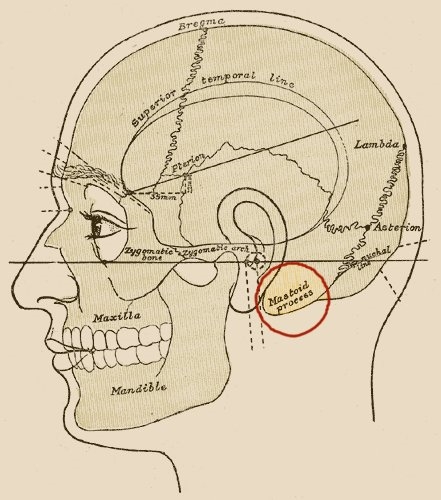Cranial Electric Stimulation (CES)
http://www.eegbiofeedback.cz/e-stim/cesky/cesky.php?menu=popismet
http://www.mindalive.com/1_0/techtalkceswaveforms.htm
notes:
- Maximum <1.5mA Peak ~40 Volts Peak-Peak into typical 4k ohm load. Minimum <~10 microamperes, 10 Volt Peak-Peak at the lowest setting
- Output impedance ~20k ohm
- Modified rectilinear wave with rapid rise time (under 1uS). There are over 500 harmonic frequencies delivered in each pulse as observed on a frequency domain (not time domain) spectrum analyzer
- Base waveform (Mode 1) 1,000 Hz Square wave (+/- 1%) pulse-modulated by 111.11 Hz (+/- 1%) Square wave. Waveforms are Microchip Quartz Crystal-Controlled for precise frequency output. There are 6 user-selectable output Modes
- 9-Volt DC Alkaline Battery operation, useful to end voltage ~6.2 Volts. Battery drain: minimum ~9mA @ 9 Volts to maximum of 30mA with output fully loaded* Low battery indicator.
- Pulses are Bi-Phasic (AC) with no DC or offset bias. Output is transformer coupled so that no direct current can appear at electrodes. The algebraic sum of positive and negative-going pulses is zero. This obviates any possibility of electrolysis, ion migration, or polarization.
- MODE 1-3 (550uS pulse width)
- Mode 11,000 Hz modulated by 111.11 Hz, 550uS Pulse WidthOutput = Continuous
- Mode 2 1,000 Hz modulated by 111.11 Hz, 550uS Pulse WidthOutput = 1 Second ON, 1 Second OFF
- Mode 3 1,000 Hz modulated by 111.11 Hz, 550uS Pulse Width
- Output = Amplitude Modulated by 7.83 Hz Schumann (Earth) Sine Wave
- MODE 4-6 (220uS pulse width)
- Mode 4 1,000 Hz modulated by 111.11 Hz, 220uS Pulse Width Output = Continuous
- Mode 5 1,000 Hz modulated by 111.11 Hz, 220uS Pulse Width Output = 1 Second ON, 1 Second OFF
- Mode 6 1,000 Hz modulated by 111.11 Hz, 220uS Pulse Width Output = Amplitude Modulated by 7.83 Hz Schumann (Earth) Sine Wave
CES Ultra Primary Specifications
- Frequency: 100 Hz. and .35 Hz.
- Power Source: 9V Battery (Incl.)
- Amplitude: 10-600 micro amps (continuously adjustable)
- Wave Shape: Modified Sinusoidal
- Waveform: Bipolar asymmetric rectangular
- Amplitude: 0-1.5 Ma. (skin resistance considered)
- Duty Cycle: 50%
- Pulse Duration: 2 milliseconds (20% duty cycle)
- Timer Control: 30 min. & 45 min.
Biedebach12 has argued that treatment efficacy is determined by certain microcurrent waveform parameters. Research suggests that N-type voltage-sensitive calcium channels in cell membranes are more effectively opened by short electrical pulses.13 Other work suggests that L-type voltage-sensitive calcium channels are more effectively opened by longer pulses.14 N-type channels tend to predominate on sensory neurons and stimulate the release of powerful vasodilating substances such as calcitonin gene-related peptide, whereas L-type channels predominate on fibroblasts.15 Theoretically, it would be advantageous for a microcurrent device to incorporate both characteristics into its waveform, and to adjust each component in response to changing tissue electrical impedance in an attempt to optimize the effect. One microcurrent device (Figure 1) addresses this issue.16 The current waveform (Figure 2) has an “overshoot” phase, which acts as a short-duration pulse to open N-type channels, and a longer duration “plateau” phase to open L-type channels. In 1 model, the current overshoot is maintained between 1.5 and 2.0 mA. The width of the overshoot (measured at the 1.0-mA level) is automatically adjusted between 100 and 300 microseconds by a feedback mechanism in response to the measured tissue impedance. The width of the overshoot increases with decreasing tissue impedance; this is believed to open more N-type channels. The plateau phase width is automatically adjusted between 2 and 200 milliseconds commensurate with tissue impedance in an attempt to optimize the opening of L-type channels. The amplitude of the plateau phase is determined predominantly by the manually adjusted intensity dial on the outside of the device. A train of positive-going “carrier pulses” is followed by a train of negative-going carrier pulses to complete a 4-second repeating cycle (Figure 3). The carrier pulse frequency is adjusted manually by the frequency dial. Treatment is rendered by use of attachable electrodes including (but not limited to) brass “mini plates,” “point-specific probes” with brass tips, “transcranial clip” (earclip) electrodes, and an “auricular probe” with a thin, spring-loaded, stainless steel tip for the detection and treatment of auricular points (Figure 4).
Variace CES Ultra
- Frequency: 100 Hz
- Waveform: Bipolar asymmetric rectangular
- Duty Cycle: 50%
- Pulse Duration: 2 milliseconds (20% duty cycle) - 20us peak- 1 180us - 0,6 pauza 100us
- Time : 30 min
- Signal :stereo (R-20dB)
- Device: Mp3 player + small amplyfiler




